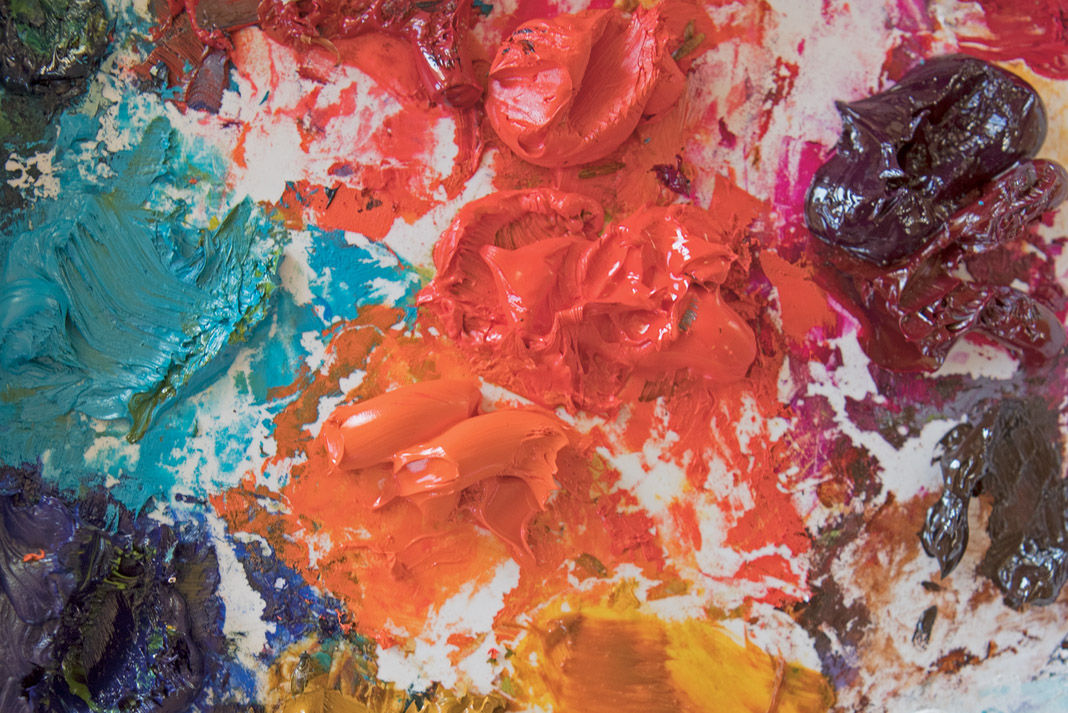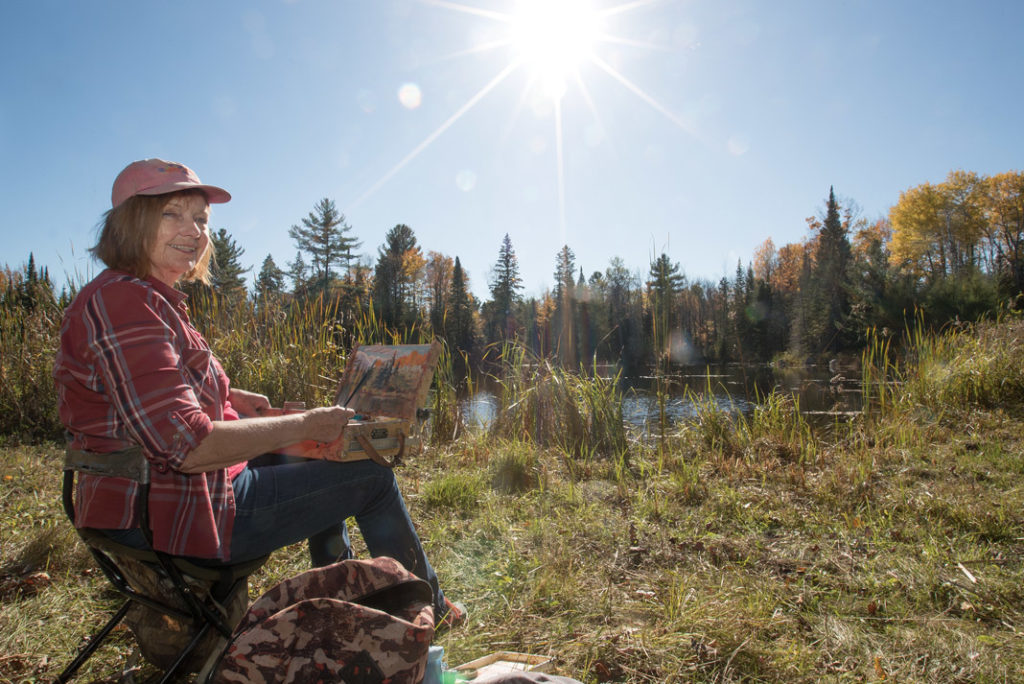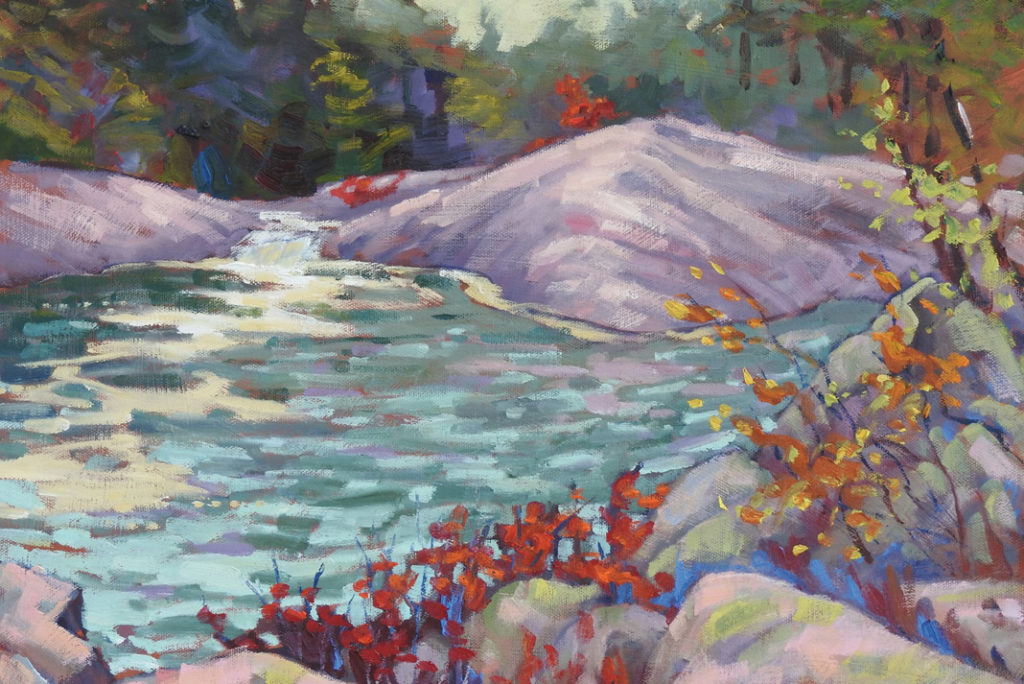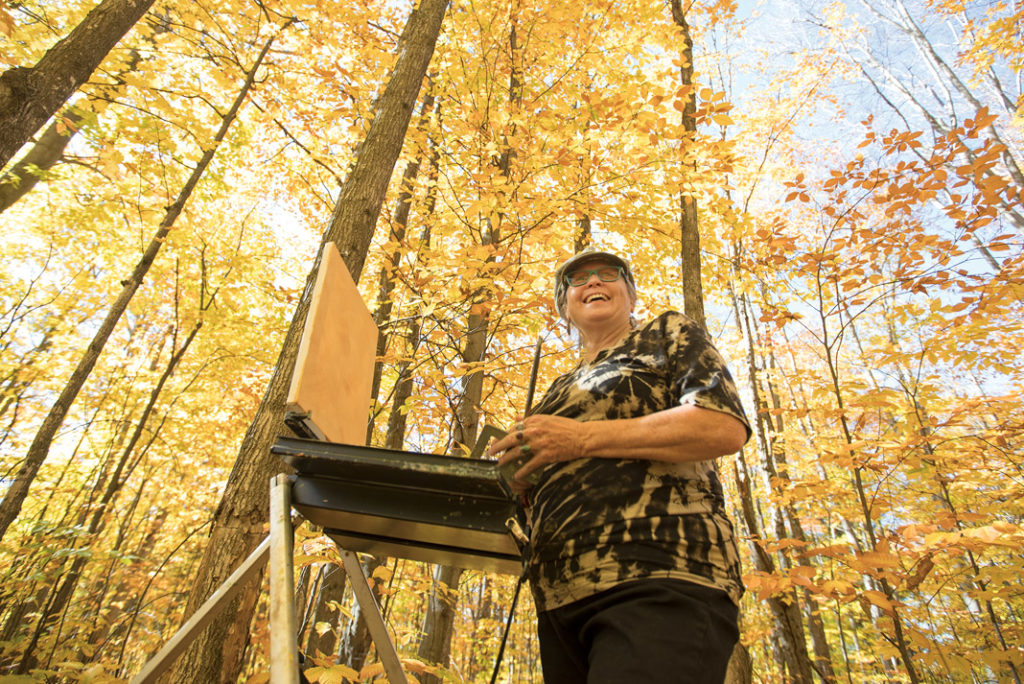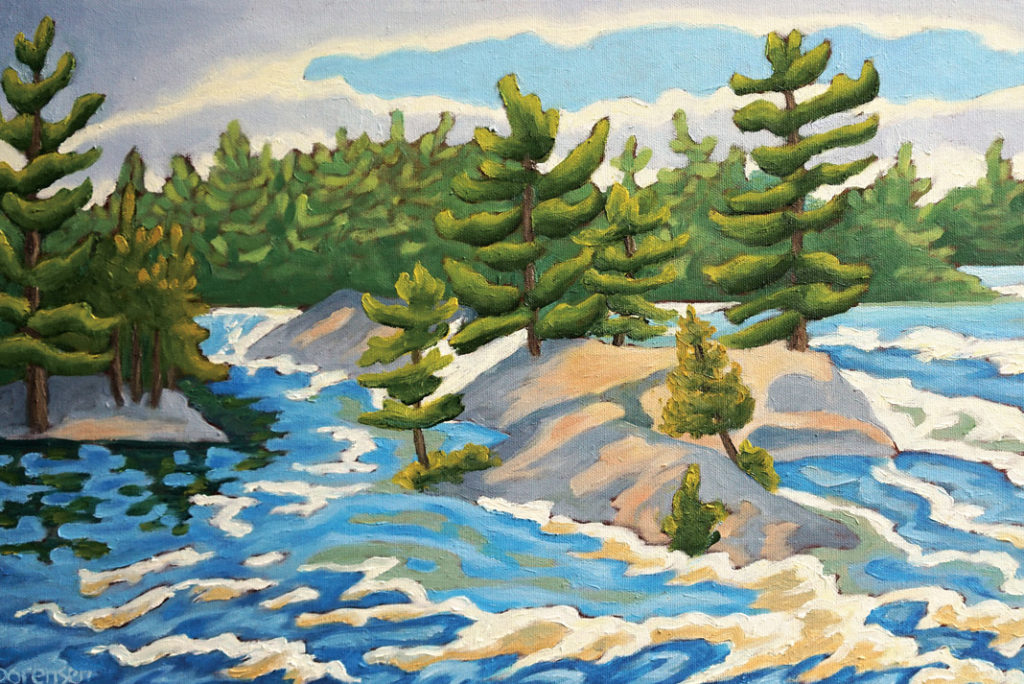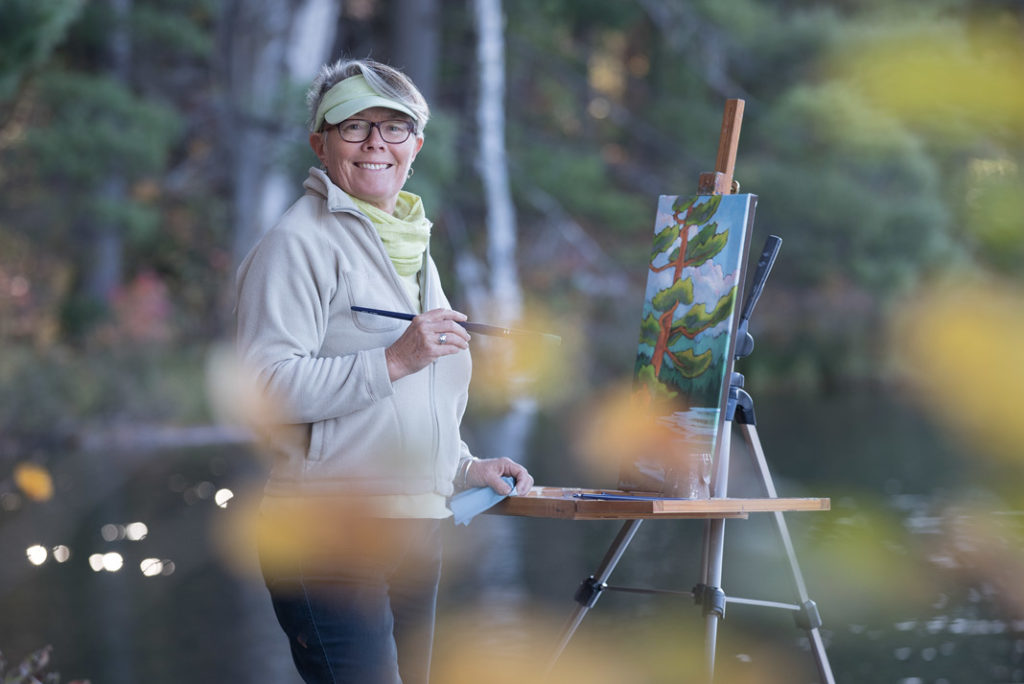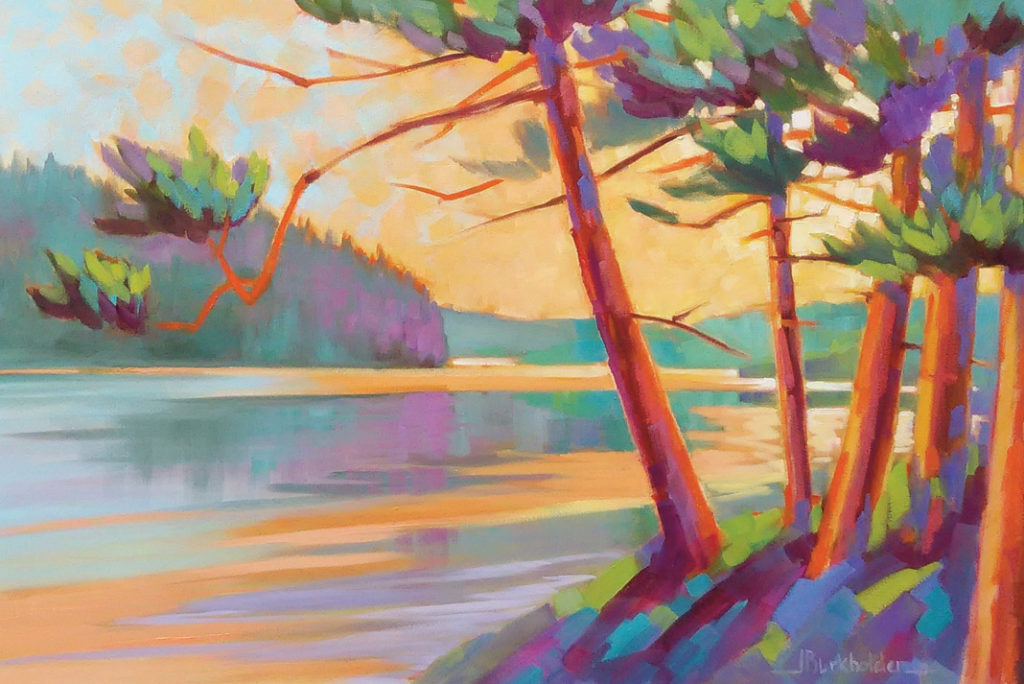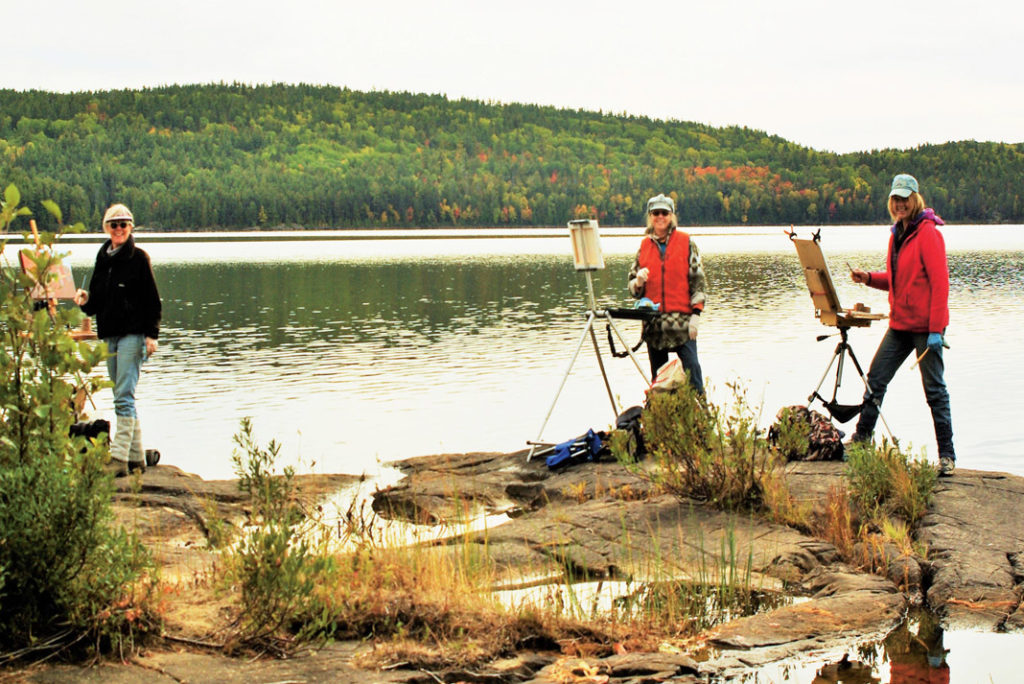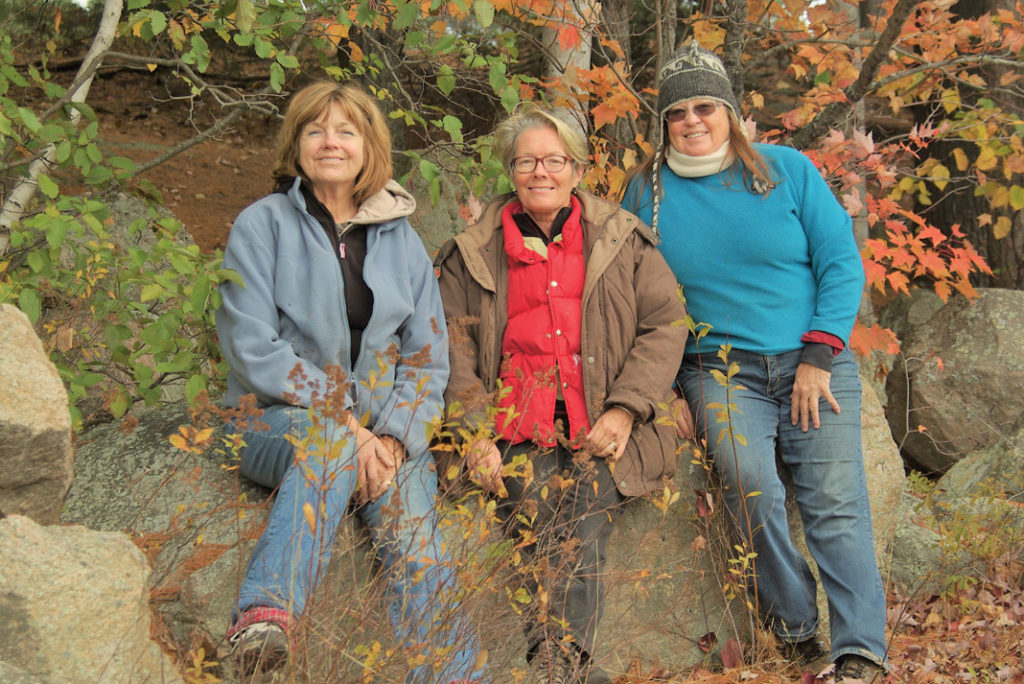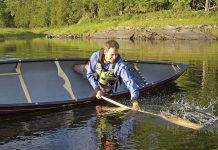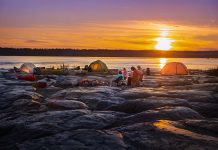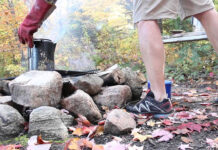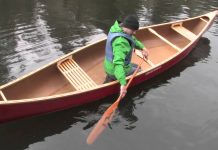At least once a year for the last 10 years, artists Kathy Haycock, Linda Sorensen and Joyce Burkholder have loaded up canoes or their backpacks and embarked on a painting adventure somewhere in the wilderness of Algonquin Provincial Park.
There they pitch tents, hook up a trailer or rent a cabin and venture out on their own for hours at a time. In this wilderness cherished by backcountry canoeists, they commune with nature and paint in solitude, reconvening each evening to share and critique each other’s work over a cold beer and some good food.
The excursions are an annual highlight for the Wild Women of Renfrew County, Ontario, a three-hour drive west of the nation’s capital, Ottawa.
The threesome meet often, taking day trips into the wilds closer to home. They snowshoe in winter and hike and paddle in summer, setting up their easels alongside the lakes and marshes, rivers and streams, in the forests, on the hilltops, and along the shorelines of the Canadian Shield.
They Paint The Distinct Landscape—Its Trees And Waters, Rocks And Vistas—In All Its Seasons, Hues And Moods
The subject matter, its ruggedness, the windswept white pines, silvery blue waters and rocky shores, draws inevitable comparisons to the Group of Seven, but their varying styles differ greatly from the likes of Franklin Carmichael or A.Y. Jackson. It’s brighter, warmer, less desolate, and more whimsical and welcoming.
Along the way, the three earthy women have carved their own niche and cemented their reputations both as a group and as individual artists thanks, in part, to their well-received book, Wild Women: Painters of the Wilderness.
Published three years ago and now in its second printing, the volume was a labor of love. More than just a story of three female artists and their burgeoning success, Burkholder says the book is “largely about the wilderness—painting the wilderness, preserving the wilderness, celebrating the wilderness, and sharing with people there is still wilderness out there in all its glory and beauty.”
In her forward to the book, Carol Heppenstall, director of arts and culture at Adventure Canada, says the three have followed in the footsteps of Emily Carr and Doris McCarthy, immersing themselves in the natural world, “searching for its essence and the emotional pull of the wild.”
“En Plein Air [Outdoor Or On-Site] Painting Requires An Adventurous Spirit Present In All Three Women,” Heppenstall Writes
Unbeknownst to one another at the time, the three painters came from diverse backgrounds to become self-described hippies on 1970s-era communes around Renfrew County, living for years off the land without electricity or running water.
There were communes scattered all over the region then. The rural setting was ideal for the counter-culture growing out of youthful idealism and discontent with the materialism of urban life, a shift in North American values and the violence of the Vietnam era.
It was a time, says Burkholder, when “you could make almost anything by hand and sell it.”
To one degree or another, all at some point in their creative lives were fabric artists. Now in their mid-60s, each came to painting by a different route. They met years after their hippie lives had faded into the past, though not from memory.
Burkholder and Haycock began painting together 12 years ago
Sorensen, until then primarily a studio artist, joined them two years later. For these three women, strength came in numbers.
“Each of us brought something to the group. It might have been places we knew, connections we had. The sharing has been invaluable. We’ve all grown as artists as a result,” says Sorensen.
All live well off the beaten path, yet scores of collectors manage to find them at all times of year and during the twice-annual studio tours organized by 20 to 25 area artists and tourism associations.
“It’s not easy for artists to co-operate,” says Burkholder. “I think out there in the art world, it’s competitive. There are a lot of people painting—a lot of good painters. And it’s not easy to retail your work.”
But we have all hugely gained from being mutually supportive and sharing the promotion and the work of putting on exhibitions, hauling things around, and the cost. We all have had to put our egos aside and realized we’re greater if we work together,” she adds.
For all their time together and the similarities in the subject matter they paint, their evolving styles, colors and mediums have always differed. Even when they paint side-by-side, they are each in their “own little world in the wilderness,” says Haycock.
Kathy Haycock’s roots in art are deep
Her father was Maurice Haycock, an Ottawa-based geologist-turned-celebrated artist of the North. Yet Kathy didn’t turn to painting in a serious way until later in life, 10 years after her father died in 1988.
Her earliest memories are of him returning home from extended trips to the Arctic, crates of paintings in tow and a headful of spellbinding bedtime stories to tell. The walls of their home were lined with paintings from a variety of artists.
“He was always gone every summer when I was growing up and he’d bring home all these paintings of faraway places. It’s not pictures I saw, I saw paintings—his interpretation of these places. I was just entranced there was this incredible, friendly world out there that was so vast.”
Haycock Is The Only One Of The Wild Women Without Formal Training As An Artist
She painted with her father once, but didn’t take it up again until after his death when her sister arrived on her doorstep with some of his equipment.
Until then, she’d been a weaver, making tapestries and selling through a now-defunct Ottawa gallery. She’d moved to Renfrew County, taken up the hippie life and eventually began building log homes with her husband.
After her first painting, “I couldn’t think about anything else,” she says. “I felt so elated. This glow lasted a couple of days, and then it started to recede until I went and painted another one. And then I felt that way again. I think it must be like an addiction. It still is.”
A biker who’s owned everything from a Honda to a Harley, Haycock has painted all over the North, the West and the American Southwest, but the Algonquin region is the place she has felt most at home since she moved here decades ago.
For her, the challenge and the satisfaction lies largely in capturing the character and the feeling of the country. She’s found her own way in what she calls canoe painting, a form of landscape artistry she first experimented with on an Arctic cruise, then refined while exploring Alberta’s Kananaskis country.
She doesn’t paint canoes—the only one of the Wild Women who doesn’t.
She paints from canoes as she and her husband leisurely putter along a river or a lake, powered by a small trolling motor and a five-hour battery.
“The scene moves by slowly as I paint it,” she explains. “The angle changes, yes. But I’m painting the character of the country. In painting, it doesn’t have to be a picture-perfect rendition of a thing. You don’t get obsessed with the stupid little details.”
Linda Sorensen Was Born In London, England, And Came To Burlington, Ontario, At Age Two
She received her baptism in art from none other than famous wildlife painter Robert Bateman, who was her art teacher at Lord Elgin—now Robert Bateman—High School.
“He was fabulous,” she says. “He was just very passionate about what he was doing, teaching art. At the time, he was not famous, but he was an advocate for the environment, so he passed on his values about it. He’d been all over the world.”
The stories he told, the art he discussed, the passion he exuded—it was all his own. And it made him all the more inspiring, Sorensen says. She took four hours—half her curriculum—of Robert Bateman a day: painting, drawing, pottery and art history. She took textiles from Birgit Freybe, who would later become Bateman’s wife. Freybe even wrote an endorsement for the Wild Women book.
“Bateman was instrumental in my development,” said Sorensen. “He believed in me as a young, creative person. He kind of took me under his wing and nurtured my ability and my interest.” The two remain friends and correspond.
Except for “some dabblings in different mediums,” Sorensen would eventually drift away from the traditional arts, for 25 years devoting her creative energies instead to raising three children.
“It became my art,” she says. “We did the pioneer thing. We built a log cabin. We renovated an old horse stable. We grew gardens, fed the family, raised chickens and ducks. I was very much into the self-sufficient thing. I had a friend who used to say ‘art in everyday living.’ I adopted this as my philosophy. I was just totally enchanted by the lifestyle.”
She returned to painting the same year Haycock took it up, 1998
Ensconced in her home, now studio, deep in the woods south of Renfrew, she was determined to make a living at it.
Her work is diverse and popular. She branched into wilderness cards, now her bread and butter, and established a base of clientele all over the region, from the Canadian Canoe Museum in Peterborough, Ontario, to a gift store in Algonquin Park, along with galleries and shops scattered across the region.
She paints in water-mixable oils—smaller works en plein air; larger, more detailed stuff in-studio.
It’s taken 10 years to learn how to feel comfortable and be happy with the outdoor work,” she says. “Painting outside has a much more organic feel to it.
Comfort is reflected in the popularity of her work. Like the others, she has, for all intents and purposes, “made it” as an artist, though she’s reluctant to say so. “How do you define ‘make it?’ Is it money? Is it how you personally feel? I think I’m approaching that place, in that I’m making a better living. If money reflects success, I would say I’m starting to feel successful at what I’m doing.”
There was a time when Joyce Burkholder had a gallery in the nearby village of Wilno
Famous for its tavern, and showed her work at least 10 times a year at exhibitions across Southern Ontario and beyond.
She has long since moved her paintings into the forested backcountry south of Wilno (population: 300) where, like her two colleagues, she has her own home studio and gallery. She brings her pieces out only once a year to exhibit with the other Wild Women. The rest of the time, art enthusiasts flock to her door.
Educated at the Ontario College of Art, the Toronto-born Burkholder knew from an early age what she wanted to do and her dream never died. She moved to a commune in 1970, where she was “totally happy” for 20 years living on her own in a 16- by 16-foot cabin, selling art and living off the land. “The whole deal, I did it, big-time,” she says.
She was a weaver, then started painting on silk, moving on to watercolors, then acrylics
Now she paints in oils on canvas almost exclusively, though she teaches the gamut.
She attended workshops, admired other painters, and studied with many of them.
“But I think I’m mostly enthralled and ecstatic about just being in nature,” she says. “It’s so mind-blowing. There’s always something to see—some effect of the light, some phenomenon like mist. There’s always something, and it’s inspiring.”
After 35 years, the changes remain subtle; the excitement is anything but. “Whenever I arrive somewhere and set up to paint, I’m shaking. I’m just ecstatic. It’s a rush,” she says.
Burkholder was painting outdoors with various groups before she was introduced to Haycock. She loved the supportive, inspiring aspect of sharing the work and experiences of other artists.
She doesn’t remember how the two met “as painters,” but Haycock says they likely first set eyes on one another three decades ago when she and a friend rode their motorcycles over to Burkholder’s neighbouring commune in Maynooth, Ontario.
Burkholder remembers two tall girls arriving one day on bikes. They had no way of knowing at the time how their lives would ultimately intertwine.
They formalized their artistic relationship two years after getting together when they brought Sorensen into the fold, deciding on the name Wild Women: Painters of the Wilderness, along with a plan to exhibit together and support each other
“People remember the name, I’ll tell you. They’ve all got a joke about it, too. But that’s okay.”
Their collective and individual popularity alike soared after the book’s publication.
Burkholder’s work is constantly in evolution. “I feel like I have a whole bunch of styles and like every painting is possibly a different approach. So I’m always changing. I strive to change; I want to change.”
The Wild Women’s art has seen them through good times and bad. It has been their sanctuary and their outlet, their support and their sustenance—both spiritual and material. It is at the center of their souls, never far from their consciousness. And neither are they, from one another.
Time goes by and the emails will inevitably start. Scattered, at first. Then the pace picks up, and pretty soon an excursion is on the books. A day trip. It may be into Algonquin Park, by a lake someplace, or out to a cottage. They’ll meet there, bringing their hiking boots, snowshoes or a canoe.
The Wild Women are on the move
They’re more confident now, and less anxious to forego their hard-earned creature comforts as they venture into the unknown.
Still, they go. The anticipation is more than they can bear. Art is about to happen.
Stephen Thorne has been telling stories for more than three decades. In his work as an award-winning journalist, Stephen has lunched with Taliban warlords, dove in a mini-submarine to a previously undiscovered WWII shipwreck, and rode the train with Pierre Trudeau’s casket as the former prime minister traveled home for the last time. Stephen now enjoys exploring the lighter side of life from Ottawa, Ontario.



